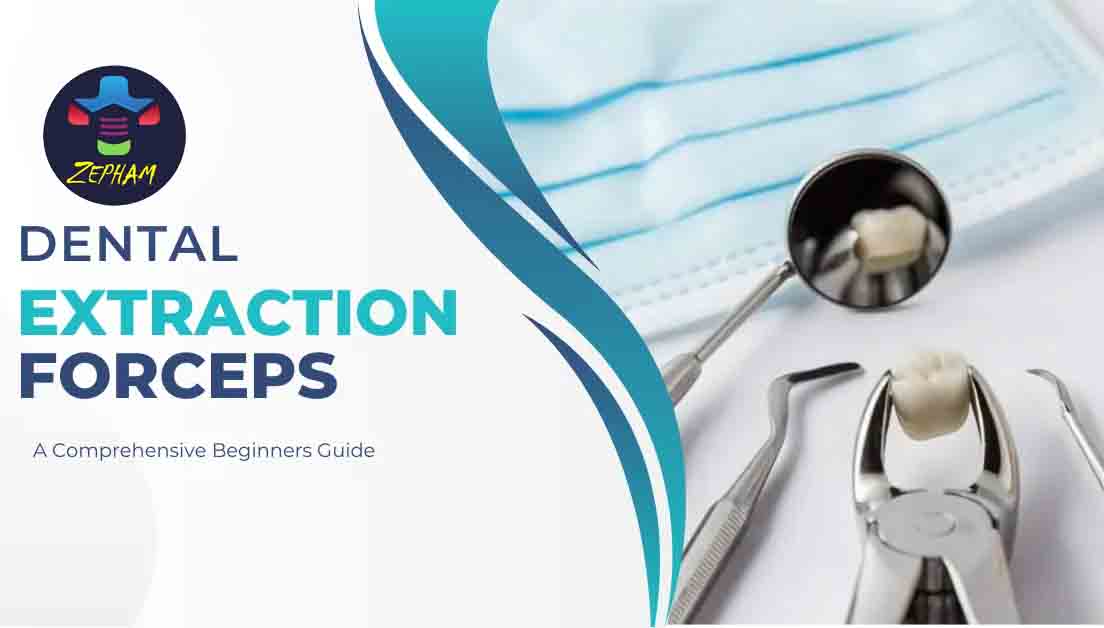Dental Extraction Forceps: A Comprehensive Beginners Guide
Dental extraction forceps, popularly named extraction forceps are made expressly to grab and extract teeth from their sockets. To fit varied tooth kinds and positions in the mouth, these incredible tools are available in a variety of forms and sizes.
Dental extraction forceps, popularly named extraction forceps are made expressly to grab and extract teeth from their sockets. To fit varied tooth kinds and positions in the mouth, these incredible tools are available in a variety of forms and sizes.
When extracting teeth, dentists frequently utilize extraction forceps, which provide them with a tight hold on the tooth to make removal easier and less traumatic for the surrounding tissues.
Primarily, these variations of extraction forceps are divided into the following sections:
Universal Extraction Forceps: These are adaptable forceps made to remove a range of teeth from various parts of the mouth. To securely hold onto the tooth, universal extraction forceps usually have a wide, flat beak.
Specific Extraction Forceps: These forceps are intended for use with particular teeth or sets of teeth. Their distinct forms and angles are designed to fit the specific architecture of the teeth they are meant to remove.
Why Extraction Forceps are Important?
Extraction Forceps are important and considered a dependable choice for dentists. They play a vital role during the surgery for multiple reasons. Before moving forward, let’s have a swift review below:
- Made expressly to grab and extract teeth from their sockets, extraction forceps are used to remove teeth. They give the dentist a firm hold on the tooth, facilitating a quick and precise extraction.
- During the extraction procedure, extraction forceps help reduce trauma to the surrounding tissues by firmly grasping the tooth. This lessens the possibility of harm to the neighboring teeth, bones, and gums.
- Using the right extraction forceps can help maintain the integrity of the surrounding bone and soft tissue, which will help the area heal as best it can after the extraction process.
- To fit diverse tooth kinds and oral sites, extraction forceps are available in a range of sizes and forms. Because of their adaptability, dentists can successfully remove a variety of teeth from incisors to molars in different parts of the oral cavity.
- By using extraction forceps to pull teeth quickly and with minimal discomfort to the patient, dentists can extract teeth more efficiently.
- The ability to precisely regulate the extraction process is made possible by the design of extraction forceps, which lowers the possibility of complications such as tooth fracture or harm to nearby structures.
- By offering a firm grasp on the tooth and enabling a smooth extraction, properly utilized extraction forceps help reduce the patient’s suffering throughout the treatment.
Basic Extraction Forceps Patterns
In a dentist’s toolbox, extraction forceps are an essential tool that is fundamental for easy and secure extraction of teeth. It’s equally important to know which forceps are best for each tooth, though. Let’s examine the various types of extraction forceps and determine which one is best for each dental situation.
When we talk about surgical extraction forceps, two commonly available designs/patterns come into account. One is the American Pattern and the other is the English Pattern. Let’s study what these are in real.
English Pattern Extracting Forceps
Distinguished by parallel-length, straight handles. These forceps are frequently thought to have finer tips and a more delicate grasp. In certain European nations including the United Kingdom, they are widely utilized and are popular among dentists and practitioners.
For Upper Teeth
Cowhorn Teeth
The term “cowhorn teeth” describes a characteristic of English pattern forceps’ beaks. The inner surface of the beaks has ridges that are curled or crescent-shaped, giving them a horn-like appearance. Cowhorn teeth are made to offer a firm hold on the tooth that needs to be pulled, improving stability and control while the process is underway. When it comes to holding and removing teeth with curved or uneven root formations, they are especially helpful.
Tri-Point Beaks
Another type of design element on the points of English pattern forceps is tri-pointed beaks. These beaks may make many points of contact with the tooth because of their three-pointed or pronged tips. Tri-pointed beaks decrease the possibility of slippage during extraction by providing more stability and grip. When it comes to extracting teeth with difficult root configurations or irregular shapes, they work particularly well.
American Pattern Extracting Forceps
The handles of these forceps are slightly curved outward to give the dentist a more comfortable grasp. Generally, American forceps have stronger and wider beaks than English forceps. Designed for a tighter grip, they are extensively used in the United States and are especially useful for extracting larger teeth or teeth with many roots.
For Lower Teeth
Bayonet Pattern
The term “Bayonet pattern” describes a type of dental extraction forceps that is distinguished by its handles, which feature an angled or curved design that mimics a bayonet. During tooth extraction treatments, the dentist can better reach and manage the area using the ergonomic grip that these forceps give, especially in spaces with limited vision. Depending on the exact style and handle curvature, bayonet pattern forceps are frequently used to remove both upper and lower teeth.
Left/Right Pairs
The forceps on the left and right are made to take into account the top dental arch’s curve.To correlate with the respective sides of the mouth, these forceps’ handles are usually curved or angled in different directions. The handles of the forceps on the left and right, for instance, will curve or angle in the direction of the respective forceps’ handles. Dentists may remove upper teeth quickly and painlessly while causing the least amount of damage to surrounding tissues when using these left and right sets of forceps to ensure optimal access and control during extractions.
Types of Extraction Forceps
There are many different kinds of forceps, each designed to fit a particular tooth or group of teeth. Factors like as the patient’s age and tooth position determine the best option.
Maxillary
Forceps #99 and #150 are recommended for extractions of anterior and premolar teeth. Straight handles and beaks on Forceps #99 complement the shapes of the lingual root and the face, providing adaptability in both the right and left quadrants. Similar shaped beaks apical to the cervical line are provided by forceps #150, guaranteeing a successful extraction.
The best forceps to use to extract maxillary first and second molars are #18L, #18R, #53L, #53R, #88L, and #88R. These forceps have differing beak forms to accommodate the roots of maxillary molars, and they are labeled L or R for the left and right quadrants, respectively.
The preferred forceps for extracting maxillary third molars are #210, which have a universal bayonet design that works with both quadrants.
Finally, forceps #65 and #69 are advised for anterior and root tip extractions. The universal bayonet design of forceps #65 allows for easy access to fragments, hard-to-reach teeth, and the root ends of maxillary overlapping anteriors. For both maxillary and mandibular overlapping anteriors and root tips, forceps #69 have the same function.
Mandibular
The best tool for handling mandibular anteriors and root tips is Forceps #74, which has a universal bird beak design. While #103 and #151 are necessary for mandibular anteriors and premolars, forceps #101 are best suited for deciduous teeth and mandibular anteriors. While #103 has straight handles and beaks, forceps #101 and #151 have universal bird beak designs.
First and second mandibular molars can be removed with forceps #15, #17, #16, and #23. Although forceps #15 and #17 have straight handles and curved ones, respectively, they are comparable instruments. The cowhorn beak on forceps #16 and #23 is a universal design.
The recommended tool for removing mandibular third molars is Forceps #222, which has a universal bayonet design that easily fits the curvature of the lingual root and the face.
Where to Buy Tooth Extraction Forceps?
Using the correct tooth extraction forceps is essential to successful and effective dental procedures. It is crucial to have a variety of forceps that are well-suited to various tooth types and extraction situations, regardless of whether you are extracting anterior teeth, premolars, molars, or root tips. We, at Surgical Mart, have a large assortment of premium extraction forceps that are made to satisfy the various requirements of dental practitioners. Our products, which range from general dental surgical instruments to customized packs and set options for certain teeth and individuals, are made with durability and accuracy in mind. Click this link to find out more about the current discounts and new collections.




